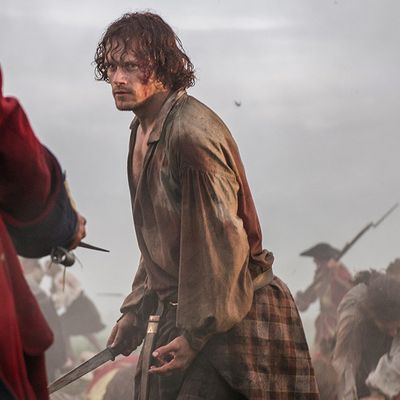
Spoilers ahead for Sunday night’s episode of Outlander.
Despite its penchant for glowing cinematography and beautiful knits, Outlander can be anything but escapist. Case in point: On Sunday night’s episode, “Surrender,” Jamie’s young French protégé, Fergus, gets his hand chopped off in a brutal closeup. Romann Berrux, the actor playing Fergus, squeals in pain. The blood spurts. His hand writhes nearby.
“We wanted it to be in your face,” Outlander’s VFX supervisor Richard Briscoe told Vulture. “And we wanted to film his reaction as it happened.” In order to capture the intensity of the scene, the Outlander crew filmed the shot twice to get the action just right, once without the sword, and once with it and a fake foam arm, as Berrux kept his arm safely at his side. The first set of takes allowed them to capture Berrux’s reaction and let the actor play out his arm’s — and, separately, his hand’s — final moments. The second set of takes gave them the chance to capture the action of the blade and its reflection as it came down.
Outlander’s VFX team, as you might imagine, also had to have a discussion about exactly how much blood would spurt from his arm. “It’s always a kind of trade-off between medical accuracy and storytelling,” Briscoe said. In the later shots in the scene, as Fergus grabs his arm and it starts to bleed out, the team employed a prosthetic arm. That allowed them to introduce “a fair amount” of fake blood in the scene, which they later supplemented with additional VFX blood after the fact. “In reality, unstanched, with no one holding it, [the blood] would probably go several meters,” Briscoe said of the wound, but the team decided to avoid anything that felt too surreal (or too much like Monty Python). “We don’t want it too look comical, nor do we want it to look trivial.”
Briscoe estimated that the scene took about six weeks to edit together, as the team tried out various versions of the shot, with one or two members of the Outlander VFX team working on it. In order to get the show to work, the editors have to make sure that there’s consistency between the color and lighting of the fluid (in this case, blood) throughout the scene — often, it’s this last 5 percent of effort that takes the longest.
That might seem like a lot of effort, but in the larger scheme of Outlander effects, Briscoe says, the hand chop isn’t the most difficult trick to pull off. The Battle of Culloden in the season’s first episode involved the hard work of producing many, many wounds and digitally editing in masses of soldiers into the backgrounds of shots. “There’s some stuff later in the season that’s far more complicated,” Briscoe adds, “But I can’t really talk about that.”


